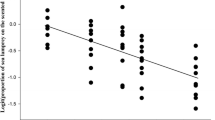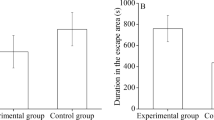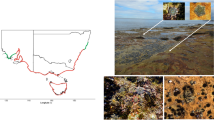Abstract
Alarm responses to the extracts of conspecifics and hetero-specifics were measured for the Caribbean sea urchins Echinometra viridis, E. lucunter, Lytechinus variegatus, L. williamsi, Tripneustes ventricosus, Diadema antillarum, and Eucidaris tribuloides collected along the Caribbean coast (9°33′14″N; 78°55′23″W) during October 1984 and July–December 1985. Responses to seawater and extracts of the gnathostomate echinoid Clypeaster sybdepressus were used as controls. The intensity of the response resulting from exposure to sea-urchin extracts was measured by: (1) the percentage of individuals that responded by moving away from the extract and/or towards shelter, and (2) the mean distance moved. Echinometra viridis, E. lucunter, and L. williamsi responded to sea-urchin extracts by moving towards nearby shelter sites. The distance that individuals of each species moved in the first minute following exposure to conspecific extracts was correlated with the distance that species moved from shelter while foraging. L. variegatus and D. antillarum, living in microhabitats not providing protection from predators, responded to extracts of conspecifics and heterospecifics by moving away from the direction of the extract. Eucidaris tribuloides did not exhibit alarm responses to the extracts of con- or hetero-specifics. E. tribuloides secures itself with its stout spines into protected sites within corals. Similarly, L. variegatus living in long, dense seagrass that provided protection from detection by predators, and D. antillarum occupying crevices, showed no alarm responses to extracts of conspecifics. Presumably, in these situations, sea urchins cannot increase their defenses against predation by moving away from an injured neighbor. T. ventricosus showed a weak response to extracts of L. variegatus, but no response to extracts of other species including conspecifics. The reasons for this lack of an alarm response are unclear. For the five species that demonstrated an alarm response to sea-urchin extracts, the intensity of the response varied depending on the type of extract used. L. variegatus, L. williamsi, and D. antillarum responded most strongly to extracts from conspecifics, while Echinometra viridis and E. lucunter responded strongly to extracts from both conspecifics and congeners. The weakest responses were shown to the extracts of T. ventricosus and Eucidaris tribuloides. Habitat overlap, overlap in predators, and phylogenetic relationships did not consistently explain patterns of alarm responses to the extracts of heterospecific sea urchins.
Similar content being viewed by others
Literature cited
Abbott, D. P., J. C. Ogden and J. A. Abbott: Studies on the activity pattern, behavior and food of the echinoid Echinometra lucunter (Linaeus) on beachrock and algal reefs at St. Croix, U.S. Virgin Islands. Spec. Publs W. Indies Lab., Fairleigh Dickinson Univ. 4, 1–111 (1974)
Alender, C. B., G. A. Feigen and J. T. Tomita: Isolation and characterization of sea urchin toxin. Toxicon 3, 9–17 (1965)
Bernstein, B. B., B. E. Williams and K. H. Mann: The role of behavioral responses to predators in modifying urchins' (Strongylocentrotus droebachiensis) destructive grazing and seasonal foraging patterns. Mar. Biol. 63, 39–49 (1981)
Bigelow, H. B. and W. C. Schroeder: Fishes of the western North Atlantic. Pt. 1. Sharks. Mem. Sears Fdn mar. Res. 1, 59–576 (1948)
Boone, L.: Echinodermata from tropical East American seas. Bull. Bingham oceanogr. Coll. 1, 1–22 (1928)
Dayton, P. K., G. A. Robilliard and R. T. Paine: Benthic faunal zonation as a result of anchor ice at McMurdo Sound. Antarctica. In: Antarctic ecology, Vol. 1. pp 244–258. Ed. by M. W. Holgate: New York: Academic Press 1970
Fricke, H. W.: Fische als Feinde tropischer Seeigel. Mar. Biol. 9, 328–338 (1971)
Hadlock, R. P.: Alarm response of the intertidal snail Littorina littorea (L.) to predation by the crab Carcinus maenas (L.). Biol. Bull. mar. biol. Lab., Woods Hole 159, 269–279 (1980)
Hoffman, S. G. and D. R. Robertson: Foraging and reproduction of two Caribbean reef toadfishes (Batrachoididae). Bull. mar. Sci. 33, 919–927 (1983)
Howe, N. R. and Y. M. Sheikh: Anthopleurine: a sea anemone alarm pheromone. Science, N.Y. 189, 386–388 (1975)
Hrbacek, J.: On the flight reaction of tadpoles of the common toad caused by chemical substances. Experientia 6, 100–101 (1950)
Hughes, R. N. and H. P. I. Hughes: A study of Cassis tuberosa (L.) preying upon sea urchins. J. exp. mar. Biol. Ecol. 7, 305–314 (1971)
Kempendorff, W.: Über das Fluchtphänomen und die Chemorezeption von Helisoma (Taphius) nigricans Spix. Arch. Molluskenk. 74, 1–27 (1942)
Lessios, H. A., J. D. Cubit, D. R. Robertson, M. J. Shulman, M. R. Parker, S. D. Garrity and S. C. Levings: Mass mortality of Diadema antillarum on the Caribbean coast of Panama. Coral Reefs 3, 173–182 (1985)
Longley, W. H. and S. F. Hildebrand: Systematic catalogue of the fishes of Tortugas, Florida with observations on color, habits, and local distribution. Pap. Tortugas Lab. 34, 1–331 (1941). (Publs Carnegie Instn 535)
Mann, K. H., J. L. C. Wright, B. E. Welsford and E. Hatfield: Responses of the sea urchin Strongylocentrotus droebachiensis (O. F. Müller) to water-borne stimuli from potential predators and potential food algae. J. exp. mar. Biol. Ecol. 79, 233–244 (1984)
Moore, H. B., T. Jutare, J. C. Bauer and J. A. Jones. The biology of Lytechinus variegatus. Bull. mar. Sci. Gulf Caribb. 13, 25–53 (1963)
Ogden, J. C.: Some aspects of herbivore-plant relationships on Caribbean reefs and seagrass beds. Aquat. Bot. 2, 103–116 (1976)
Pfeiffer, W.: The fright reaction of fish. Biol. Rev. 37, 495–511 (1962)
Randall, J. E.: Food habits of reef fishes of the West Indies. Stud. trop. Oceanogr., Miami 5, 665–847 (1967)
Randall, J. E., R. E. Schroeder and W. A. Stark, II: Notes on the biology of the echinoid Diadema antillarum. Caribb. J. Sci. 4, 421–433 (1964)
Snyder, N. F. R.: An alarm response of aquatic gastropods to intraspecific extract. Mem. Cornell Univ. agric., Exp. Stn 403, 1–126 (1967)
Snyder, N. F. R. and H. A. Snyder: Alarm response of Diadema antillarum. Science, N.Y. 168, 276–278 (1970)
Tegner, M. J. and L. A. Levin: Spiny lobsters and sea urchins: analysis of a predator-prey interactions. J. exp. mar. Biol. Ecol. 73, 125–150 (1983)
Von Frisch, K.: Über einen Schreckstoff der Fischhaut und seine biologische Bedeutung. Z. vergl. Physiol. 29, 46–145 (1941)
Waldner, R. E. and D. R. Robertson. Patterns of habitat partitioning by 8 species of territorial Caribbean damselfish (Pisces: Pomacentridae). Bull. mar. Sci. 30, 171–186 (1980)
Author information
Authors and Affiliations
Additional information
Communicated by J. M. Lawrence, Tampa
Rights and permissions
About this article
Cite this article
Parker, D.A., Shulman, M.J. Avoiding predation: alarm responses of Caribbean sea urchins to simulated predation on conspecific and heterospecific sea urchins. Mar. Biol. 93, 201–208 (1986). https://doi.org/10.1007/BF00508257
Accepted:
Issue Date:
DOI: https://doi.org/10.1007/BF00508257




